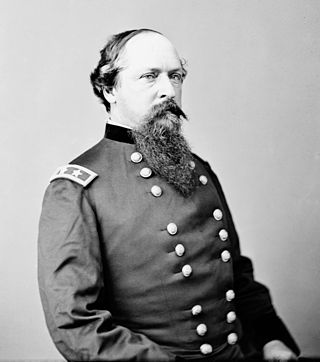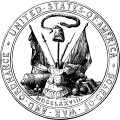Related Research Articles

The Army of Northern Virginia was the primary military force of the Confederate States of America in the Eastern Theater of the American Civil War. It was also the primary command structure of the Department of Northern Virginia. It was most often arrayed against the Union Army of the Potomac.

Philip Henry Sheridan was a career United States Army officer and a Union general in the American Civil War. His career was noted for his rapid rise to major general and his close association with General-in-chief Ulysses S. Grant, who transferred Sheridan from command of an infantry division in the Western Theater to lead the Cavalry Corps of the Army of the Potomac in the East. In 1864, he defeated Confederate forces under General Jubal Early in the Shenandoah Valley and his destruction of the economic infrastructure of the Valley, called "The Burning" by residents, was one of the first uses of scorched-earth tactics in the war. In 1865, his cavalry pursued Gen. Robert E. Lee and was instrumental in forcing his surrender at Appomattox Courthouse.

The Army of the Potomac was the primary field army of the Union army in the Eastern Theater of the American Civil War. It was created in July 1861 shortly after the First Battle of Bull Run and was disbanded in June 1865 following the surrender of the Confederate Army of Northern Virginia in April.
The Army of the Shenandoah was a field army of the Union Army active during the American Civil War. First organized as the Department of the Shenandoah in 1861 and then disbanded in early 1862, the army became most effective after its recreation on August 1, 1864 under the command of Philip Sheridan. The army's actions during the Valley campaigns of 1864 rendered the Shenandoah Valley of Virginia unable to produce foodstuffs for the Confederate States Army, a condition which would hasten the conclusion of the American Civil War.

The Battle of Cedar Creek, or Battle of Belle Grove, was fought on October 19, 1864, during the American Civil War. The fighting took place in the Shenandoah Valley of Northern Virginia, near Cedar Creek, Middletown, and the Valley Pike. During the morning, Lieutenant General Jubal Early appeared to have a victory for his Confederate army, as he captured over 1,000 prisoners and over 20 artillery pieces while forcing seven enemy infantry divisions to fall back. The Union army, led by Major General Philip Sheridan, rallied in late afternoon and drove away Early's men. In addition to recapturing all of their own artillery seized in the morning, Sheridan's forces captured most of Early's artillery and wagons.

Alfred Thomas Archimedes Torbert was a career United States Army officer, a Union Army General commanding both infantry and cavalry forces in the American Civil War, and a U.S. diplomat.

Horatio Gouverneur Wright was an engineer and general in the Union Army during the American Civil War. He took command of the VI Corps in May 1864 following the death of General John Sedgwick. In this capacity, he was responsible for building the fortifications around Washington DC, and in the Overland Campaign he commanded the first troops to break through the Confederate defenses at Petersburg. After the war, he was involved in a number of engineering projects, including the Brooklyn Bridge and the completion of the Washington Monument, and served as Chief of Engineers for the U.S. Army Corps of Engineers.
The Army of West Virginia served in the Union Army during the American Civil War and was the primary field army of the Department of West Virginia. It campaigned primarily in West Virginia, Southwest Virginia and in the Shenandoah Valley. It is noted for having two future U.S. presidents serve in its ranks: Rutherford B. Hayes and William McKinley, both from the 23rd Ohio Infantry. With fighting in the Valley ended, the Army of West Virginia's designation was discontinued.

Robert EmmettRodes was a Confederate general in the American Civil War, and the first of Robert E. Lee's divisional commanders not trained at West Point. His division led Stonewall Jackson's devastating surprise attack at the Battle of Chancellorsville; Jackson, on his deathbed, recommended that Rodes be promoted to major general. Rodes then served in the corps of Richard S. Ewell at the Battle of Gettysburg and in the Overland Campaign, before that corps was sent to the Shenandoah Valley under Jubal Early, where Rodes was killed at the Third Battle of Winchester.

The Valley campaigns of 1864 began as operations initiated by Union Lieutenant General Ulysses S. Grant and resulting battles that took place in the Shenandoah Valley of Virginia during the American Civil War from May to October 1864. Some military historians divide this period into three separate campaigns. This article considers them together, as the campaigns interacted and built upon one another.

The VIII Corps was a corps of the Union Army during the American Civil War.

XIX Corps was a corps of the Union Army during the American Civil War. It spent most of its service in Louisiana and the Gulf, though several units fought in Virginia's Shenandoah Valley.
The Stonewall Brigade of the Confederate Army during the American Civil War, was a famous combat unit in United States military history. It was trained and first led by General Thomas J. "Stonewall" Jackson, a professor from Virginia Military Institute (VMI). His severe training program and ascetic standards of military discipline turned enthusiastic but raw recruits into an effective military organization, which distinguished itself from the First Battle of Bull Run in 1861 to Spotsylvania Court House in 1864. Its legacy lives on in the 116th Infantry Brigade, which bears the unofficial nickname "Stonewall Brigade," and in several living history reenactment groups.

James Brewerton Ricketts was a career officer in the United States Army, serving as a Union Army general during the Civil War.

The Second Corps of the Army of Northern Virginia was a military organization within the Confederate Army of Northern Virginia during much of the American Civil War. It was officially created and named following the Battle of Sharpsburg in 1862, but comprised units in a corps organization for quite some time prior to that. The Second Corps developed a reputation for hard fighting under famed early commander Thomas J. "Stonewall" Jackson.

Julius H. Stahel-Számwald was a Hungarian soldier who emigrated to the United States and became a Union general in the American Civil War. After the war, he served as a U.S. diplomat, a mining engineer, and a life insurance company executive. He received the Medal of Honor for gallantry in action at the Battle of Piedmont in 1864.

James Deering Fessenden was an American lawyer, politician, and soldier from the state of Maine who served as a general in the Union Army during the American Civil War. Primarily a staff officer and operations planner until the latter stages of the war, he commanded an infantry brigade in the Western Theater in 1864 and 1865. In 1862, he organized in South Carolina what became one of the first black regiments in the Federal army. He was a member of the powerful Fessenden family, which was prominent in national politics during the mid-19th century.
The 123rd Ohio Infantry Regiment, sometimes 123rd Ohio Volunteer Infantry was an infantry regiment in the Union Army during the American Civil War.

Oliver Edwards was a machine company executive, an inventor, and a volunteer officer in the Union Army during the American Civil War.
During the American Civil War, a department was a geographical command within the Union's military organization, usually reporting directly to the War Department. Many of the Union's departments were named after rivers or other bodies of water, such as the Department of the Potomac and the Department of the Tennessee. The geographical boundaries of such departments changed frequently, as did their names. As the armies became larger Departments began to be subordinated to Military Divisions, and the Departments were often sub divided into Districts and from 1862 Subdistricts. Much information on Civil War departments can be found in Eicher & Eicher, Civil War High Commands.
References
- Eicher, John H., & Eicher, David J., Civil War High Commands, Stanford University Press, 2001, ISBN 0-8047-3641-3.
